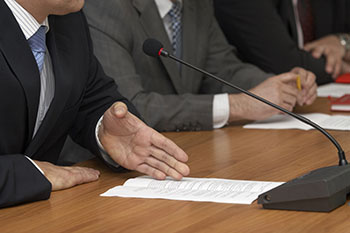Dissertation on Nuclear Security and Disaster Management
Info: 8041 words (32 pages) Dissertation
Published: 17th Nov 2021
Click to expand Table of Contents
Table of Contents
Introduction
Background
Literature Review
Theory
Emergency Management
Hazard Mitigation Planning
Preparedness
Nuclear Preparedness
Cold War Preparedness Plans
Response:
Recovery:
Mobile Alerts
False Alerts
Thesis state/purpose statement
Methodology
Analysis/Data Collection
Recommendations
Problems
During the disaster/ what to do
Limitations
Conclusion
References
Figures
1: North Korea ballistic missile range potential
2: WEAs alert in Hawaii
3: WEAs study conducted testing public’s perception
4: Federal Civil Defense, Duck and Cover Pamphlet Photo
Introduction
Preparedness is the foundation for effective disaster management and response regardless of the hazard type. As the geopolitical environment changes, emergency managers are required to expand their conceptualization of risk and hazard to include potential nuclear security threats. “The United States, as the rest of the world, faces an increasing threat of attacks with weapons of mass destruction (WMD). Of these, the most feared are the nuclear threats” (Quirk, 2018). In 2017, North Korea launched 23 missiles including its for intercontinental missile (ICBM), “is a guided ballistic missile with a minimum range of 3,400 miles, it is primarily designed for nuclear weapons delivery”. On, November 29, 2017, North Korea claimed to have successfully tested a new type of ICBM topped with a super-large heavy warhead. On January 23, 2018, the CIA directed stated that North Koreas ever closer to being able to hold America at Risk”. The figure 1 depicts, North Korea advances in 2017, and it its believed their advances will be a threat by the end of 2018. (). One way to start preparing a community for any type of threat, is by having a Hazard Mitigation Plan (HMP). To be able to protect the citizens of the United States, hazard mitigation planning needs to be addressed and include all types of terrorist attacks, including nuclear weapons. In 2000, the Disaster Mitigation Act (DMA, 2000), was developed to focus on natural hazards, however the all-hazards approach has been adopted to cover a wider range of hazards including man-made, terrorism and hazardous material. Mitigation means reducing the loss of life and property, by reducing the impact a disaster has on the affected population, when referring to terrorism, mitigation can also include preparedness and response efforts prior to an attack. (FEMA, 2003).
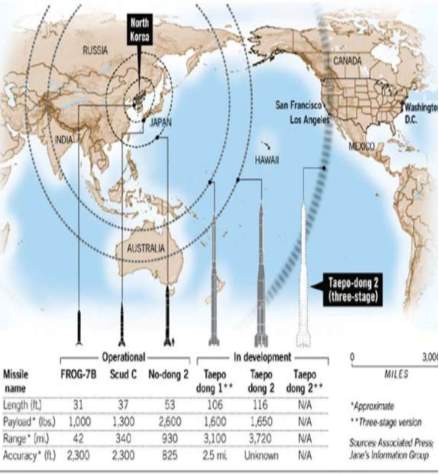
Figure 1, (Wang, 2017).
The purpose of this study is to examine Hawaii’s preparedness efforts prior to the events of 13 January 2018, when a false ballistic missile alert was issued by the Hawaii Emergency Management Agency. Ballistic missiles, according to Rand Corporation, “are short-, medium-, and long-range rocket-propelled vehicles that deliver nuclear or conventional weapons” (2018). This research will explore the public’s perception of a nuclear attack and look at best practices to prepare and respond in the event of a nuclear attack.
Background
Hawaii was selected as the case for this study based on two main factors. First, its geographical location, especially in today’s geopolitical climate where the risk of nuclear attack is high. The geopolitical climate has become increasingly dangerous in the past few years. North Korea has increased their weapons testing, which has caused worry about a potential attack on American soil. Second, Hawaii is the only United States to ever experience an attacked by a foreign government. Due to this, the events that occurred on 13 January 2018 must be contextualized. This event will help define emergency management preparedness efforts in the state moving forward.
In 1898, Hawaii was annexed by the United States through the Newlands Resolution, in 1959, Hawaii became the 50th state, however, unlike all other states, the official language of Hawaii is not English, rather it is the Hawaiian language. Hawaii is the only state that is an island, which would put the state in a unique situation in the event of a nuclear attack, due to it’s geographic location. Hawaii has eight major islands with a population of approximately 1.43 million people; Oahu is the largest with approximately 953,000 people (World Population Review, 2017). Hawaii is at risk for many natural disasters, including by not limited to tsunamis, hurricanes, and volcanic eruptions. Hawaii is also a target for manmade disasters; it is a potential target for a ballistic missile attack because, Hawaii is uniquely situated in the Pacific Ocean and is a strategic location for US Military operations for all of Asia. “Hawaii is home to the Pacific Command (PACOM) and would likely serve as an important staging area for American forces in the Pacific in the event of greater hostilities breaking out. Hawaii has played that role in every major conflict since the island nation was annexed by the United States in 1898” (Civil Beat, 2018). With North Korea expanding its nuclear capabilities and the tension between the United States and North Korea, it is critical to have an established response plan for a nuclear attack. Even so, “Hawaii, for all its beauty, is a relatively poor location to experience a nuclear strike. Its isolation offers little chance for swift evacuation and would likely complicate government efforts to provide medicine and food relief. Its prevailing high winds could have an unpredictable effect on the dispersal of radiation. Yet there is much that government officials could do that might reduce panic before a strike and hardship afterwards” (Tucker, 2018).
Hawaii’s history also plays an important role into why it was chosen as the subject of this research. Hawaii was attacked on December 7, 1941, when the Japanese launched an attack on Pearl Harbor, a United States Military base in Honolulu, Hawaii. The attack destroyed 20 ships and 300 airplanes and left 2,403 people dead and 1,000 wounded. Hawaii is located approximately 2200 miles away from the continental United States, which makes it more vulnerable to attacks and increases response time for resources from the mainland in the event that it is attacked.
On January 13, 2018, the state of Hawaii was running a drill with its Emergency Management Department, an incident occurred when an employee mistook the drill for a real event. The employee sent out a text message notification that went out to all citizens and read, “BALLISTIC MISSILE THREAT INBOUND TO HAWAII. SEEK IMMEDIATE SHELTER. THIS IS NOT A DRILL” (Berman and Fung, 2018). Many people were confused by this text message because it occurred during the drill. This also created challenges for the Emergency Management Department because, there was no notification that could be sent out immediately after to rescind the statement. Thirty-eight minutes passed before a notification was sent out saying it was a false alarm and there was not actually a ballistic missile inbound.

Figure 2 (Begnaud, 2018)
In recent history, nuclear security and threats have surfaced, especially after t 9/11 and Iran’s testing of nuclear weapons. North Korea has also shown its potential of nuclear capabilities that has led many people to be concerned. However, the last time citizens prepared for a nuclear attack was during the Cold War. The end of the Cold War “produced a false sense of security. Peace has yet to be attained…The stark realization that rogue states, and quite possibly terrorist groups, are capable of obtaining weapons of mass destruction, nuclear and otherwise, in response to U.S. foreign policy actions presents an even greater dilemma today” (DeBenedetti/Charles F. Howlett, 2009, p. 437). Therefore, it is even more important to put plans in place and help the public prepare for as potential nuclear attack. Having the proper steps documented will help to ease confusion and could save more lives if the attack does occur. While the Cold War officially ended in the early 1990s, the threat never truly left.
Literature Review
Emergency Management
An office, individual, or group of individuals focusing on emergency management are important for communities. It allows for community development, which can help increase community resilience in the face of a disaster. There are four phases of emergency management that are cycled through for any disaster: Mitigation, Preparedness, Response and Recovery. These four phases are critical because they all play a key role in improving the livelihood of the community. Emergency managers face threats in their communities every day. They must prepare for the worst-case situations before they happen. In order to do this, they must find the “most effective public warnings to issue during a hazardous environmental event” which can be complicated (Cova et al., 2016). There are various questions that must be asked, with three primary ones; “Who should take protective action? What is the best action? and When should this action be initiated?” (Cova et al., 2016).
Hazard Mitigation Planning
Hazard mitigation plays an important role in reducing societal losses from natural and man-made hazards. Many hazardous events are not preventable, however, when hazard mitigation planning is used it can reduce economic and personal losses, and enhance community resilience (Frazier, Walker, Kumari & Thompson, 2013). While hazard mitigation planning is he first step to increasing preparedness and resiliency while decreasing vulnerability, there are various reasons communities do not address all the criteria that could help them in the future. The Disaster Mitigation Act of 2000, has minimum requirements that are needed to qualify for a Federal Mitigation Grant, regardless of plan quality or if the Hazard mitigation plans applies to local hazards and risks. Emergency managers at the local level face constraints when working to include the HMPs into their locality’s comprehensive plans while trying to provide funding and focus on both the plans equally (Frazier, Walker, Kumari & Thompson, 2013). It is important to have a high-quality plan focused on the local community. The HMP should include standard hazards, but it needs to be targeted to the hazards that affect their geographic location specifically. Hazard Mitigation Plans are the first line of defense to any hazard by providing direction to preparing for an event before it happens. Having high quality, location-specific plans increase resiliency within the community, and improves mitigation which can decrease the loss of life and reduce economic impact a disaster can have on a community.
Preparedness
Preparedness is the second phase in Emergency Management. Preparedness is important because it could potentially help save lives and property if a proper plan is in place before an incident occurs. Not all preparedness efforts should look the same; each preparedness plan needs to be tailored to the region and hazards that may impact that area (FEMA, 2003). Not only should they include natural hazards, terrorism because it’s a global threat, but preparedness plans must also include threats from state actors. The United States “faces the distinct possibility of a catastrophic terrorist attack using an improvised nuclear device (IND), according to international and U.S. intelligence” (Jenkins, 2008). In the event of a detonation in a major United States city, the result would be a catastrophic number of victims. The IND detonation would overwhelm emergency response, healthcare systems, and public health, while increasing social and economic challenges with the tens of thousands to possibly hundreds of thousands of victims. While the likelihood of an IND detonation may not seem realistic, proper planning and decision making prior to an event occurring (Davis, Reeve, Altevogt, 2013).
Nuclear Preparedness
Any nuclear attack will have a catastrophic impact on a society making nuclear preparedness a critical aspect of emergency management. As emergency managers, it is our job to protect the public. In order to do this, appropriate action need to be taken based on the hazard. “Protecting the public from an airborne hazardous chemical release requires that appropriate protective actions be selected quickly. When deciding whether to recommend evacuation or shelter-in-place, decision makers must weigh the interaction of numerous factors that characterize the release, the meteorological conditions, and the populations that may be affected” (Sorensen, Shumpert, and Vogt, 2004).
Many regions have nuclear preparedness in their hazard mitigation plans. Guam is one of those locations that prepare their citizens in the event of a nuclear attack. Over the last year, Guam has given out pamphlets in the community, so people can have an idea of what to do in the event of a nuclear attack. Education, preparation and practice can make a difference between life and death in an emergency. Guam’s joint information center has released pamphlets about what to do in the event of a ballistic missile attack. It talks about preparing before an event would occur; by building an emergency supply kit, having a family emergency plan, and making a list of potential shelters, which contains a concrete barrier (Guam homeland security, 2017).
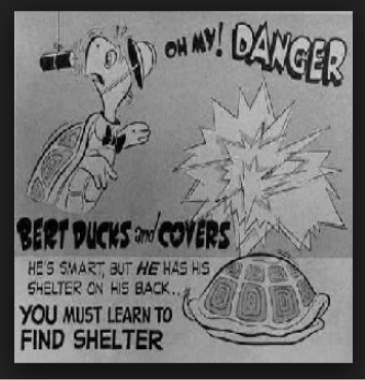
Figure 3, (Hubbard, 2018)
Cold War Preparedness Plans
Cold War preparedness plans can give us a great understanding of what nuclear preparedness looked like in the height of nuclear tension. One of the most influential documents was “Duck and Cover”, which was accompanied by a pamphlet that was shown to the public in the 1950s. “Duck and Cover” was created by the United States Federal Government, and was distributed by Federal Civil Defense Administration (FCDA), an organization that held the role of what the Federal Emergency Management Agency (FEMA) does today. During this time period nuclear security was at a heightened risk and many people were very fearful of a nuclear attack.
The production of “Duck and Cover” was due to “the massive, sometimes hysterical, response on the part of the people and the government of the United States to the Soviet Union’s acquisition of nuclear weapons and the first Soviet test detonation in late 1949. If the Soviets were to attack without warning, the children would need to know what steps to take to survive” (Jacobs, 2010). The main goal of “Duck and Cover” was to teach children how to survive without adult assistance. “Duck and Cover” was created by Archer Films under a contract with the FCDA and was shown in thousands of schools across the United States with the companion pamphlet distributed to millions of individuals (Jacobs, 2010).
The film had a cartoon mascot, Bert the Turtle, and a catchy song written by the same team whose jingle had advised Americans to “See the USA in a Chevrolet” to capture the attention of the audience (Jacobs, 2010). Preparing children for a nuclear attack was important to many people, and as historian Michael Scheibach notes, “educators, government officials, and parents realized the necessity, even the urgency, of preparing the country’s youth for a new, more precarious world” (Jacobs, 2010). In the event that parents weren’t present with their children during the nuclear attack, they the government, organized a way to identify their bodies.
Starting in 1951, private and public schools in San Francisco, Seattle, Philadelphia, and New York City issued dog tags to students. Over 2.5 million tags were issued so that in the event of a nuclear attack children could be identified and reunited with their families. FCDA education experts considered, tattoos, marking of clothes, and fingerprinting, however, dog tags are made of heat and corrosion resistant metal, so they believed this would be the better choice to help identify bodies after the nuclear attack (Jacobs, 2010). The experience that parents and children had during the Cold War were very different, “while adults perceived a threat to the American way of life–to their health and wellbeing and those of their families–their children learned to fear the loss of a future they could grow into and inhabit. These kids of the Atomic Age wondered if they might be the last children on Earth” (Jacobs, 2010).
Impact
In the late 1970s, journalist Michael Carey teamed up with psychiatrist Robery Jay Lifton to collect an oral history from adults who experienced nuclear fears while they were growing up. In 1982, an edition of “The Bulletin of Atomic Scientists” (not sure if quotes or Italics-APA check), the results of these interviews were released. Throughout the interviews, the researchers found that the nuclear scare left a permanent mark on the Baby Boomer generation. Personal recollections were shared and “One respondent from Philadelphia remembered that when, as a youngster, he had been told the United States was a melting pot, one of [his] thoughts was, ‘It really will be a melting pot’ because of that business with the bomb” (Need Citation for quote). Carey himself recounted growing up in Fairbanks, Alaska near a Strategic Air Command Base that was busy with the influx of bombers laden with nuclear weapons. He shared,
“My school had unsettling air raid drills, but I recall more vividly my terror of the citywide blackouts, when we had to cover our windows with blankets to ensure no enemy could find Fairbanks. I was curious about the bases by day but frightened of the bomb at night”
(Jacobs, 2010).
Another of Carey’s respondents recalled seeing film footage of civil defense experiments conducted at the Nevada Test Site when he was a child. One of these showed the famous explosion of House One (“Test Shot Annie,” conducted on March 17, 1953). “The thought of a building bursting into flames in that way,” explained the respondent, “is kind of startling…It undercuts the sense of reality. You kind of grow up knowing that certain things are stable…that certain presuppositions about the way things are remain constant. Namely, buildings stand. They may burn down[,] or[,] let’s say in an earthquake, they might collapse, but reality is fairly stable. When you suddenly see a picture like that, it’s kind of like getting the rug pulled out.” Another respondent told Carey of a terrifying moment in his childhood in California in the 1950s. He heard a missile test being conducted at one of the many military bases in the area, and he believed that an actual nuclear explosion was in progress. “He dived behind the couch, yelling ‘Get down! It’s happened!’ only to discover that he had made a fool of himself.”
In his book on the 1960s, the historian Todd Gitlin recounts a particularly disturbing practice in his grade school: “Every so often, out of the blue, a teacher would pause in the middle of class and call out, ‘Take cover!’ We knew, then, to scramble under our miniature desks and to stay there, cramped, heads folded under our arms, until the teacher called out, ‘All clear!’” (Jacobs, 2010). Children recall memories about growing up in the 1950s, “In 1981Albert Furtwangler, a professor of English, recalled growing up in the early 1950s in Seattle: “In fifth and sixth grades, I also dressed every morning with a bit of cold metal against my chest—a dog tag with my name and address, furnished at cost by the Parent-Teacher Association.” The military-style tags served to further signify to American children that they were soldiers in the Cold War” (Jacobs, 2010).
Response
“Response includes actions taken to provide emergency assistance, save lives, minimize property damage, and speed recovery immediately following a disaster” (FEMA, 2003).
Recovery
“Recovery includes actions taken to return to a normal or improved operating condition following a disaster” (FEMA, 2003).
Mobile Alerts
A WEA resembles a text message and indicates the hazard, the time and location of the alert, a protective action that recipients should take and the agency issuing the alert in a standard order and format. However, WEAs differ from traditional text messages in that they are geo-targeted and distributed through a wireless channel that remains unaffected during times of network congestion. WEAs also are not counted towards texting limits on a recipient’s wireless plan, are uniquely displayed on a device’s screen, are limited to 90 characters and are accompa nied by a distinctive tone and vibration, both repeated twice. Furthermore, WEAs for imminent threats, such as rapid-onset terrorism incidents, are an opt-out only system. WEAs are thus intended as a kind of first alert or warning siren in your pocket (FEMA, 2014).
Twitter can be especially effective for imminent threat alerts because of its short length (140 characters), ability to immediately alert users to new messages and capability to be accessed from mobile devices (Choi, 2012; van der Meer & Verhoeven, 2013). Unlike WEAs , tweets are not geographically targeted. Also, compared to WE As, imminent threat tweets have several distinct features:
- tweets allow for interaction with receivers through the ‘@’ replying and direct messaging functions,
- tweets are opt-in and
- Twitter allows for user customization in that audible tones and other functions can be tailored to user preferences.
Finally, Twitter is a more familiar alerting platform among U.S. audiences given that Twitter was launched in 2006, six years before the WEA system.
Mobile alerts via Wireless Emergency Alerts (WEA) and Twitter are very common in today’s world for a variety of events and emergencies. While it is very common for individuals to receive a WEA based on their community’s response plan. The implementation of the alerting system is a mitigation measure. A Wireless Emergency Alert may be the fastest way to receive information because “a WEA resembles a text message and indicates the hazard, the time and location of the alert, a protective action that recipients should take and the agency issuing the alert in a standard order and format” (Bean, et al., 2016). Two things separate WEAs from standard text messages, they are geo-targeted and sent through a specific wireless channel. By being geo-targeted, WEAs can be sent to individuals in a target a region and send out information only to any phones that ping off the cellphone towers within the set vicinity. By using a specific wireless channel, messages can be sent and unaffected even when networks are congested to ensure the messages are received in a timely manner.
WEAs are intended as a “kind of first alert or warning siren in your pocket” (FEMA, 2014; Bean, et al., 2016). This is because, “WEAs also are not part of texting limits on a recipient’s wireless plan, are uniquely displayed on a device’s screen, are limited to 90 characters, and are accompanied by a distinctive tone and vibration that are both repeated twice. Furthermore, WEAs for imminent threats, such as rapid-onset terrorism incidents, are an opt-out only system” (Bean, et al., 2016). All of these aspects of WEAs mean that unless the recipient has specifically opted out of the alert system, they will receive the notification and be informed of the imminent danger or threat. The other notification system that is commonly used is Twitter which can be beneficial because “of its short length (140 characters), ability to immediately alert users to new messages and capability to be accessed from mobile devices (Choi, 2012; van der Meer & Verhoeven, 2013). Unlike WEAs, “tweets are not geographically targeted unless specifically tagged. Additionally, compared to WEAs, imminent threat tweets have several distinct features: (1) tweets allow for interaction with receivers through the ‘@’ replying and direct messaging functions, (2) tweets are opt-in and (3) Twitter allows for user customization in that audible tones and other functions can be tailored to user preferences. Finally, Twitter is a more familiar alerting platform among U.S. audiences given that Twitter was launched in 2006, six years before the WEA system” (Bean, et al., 2016).
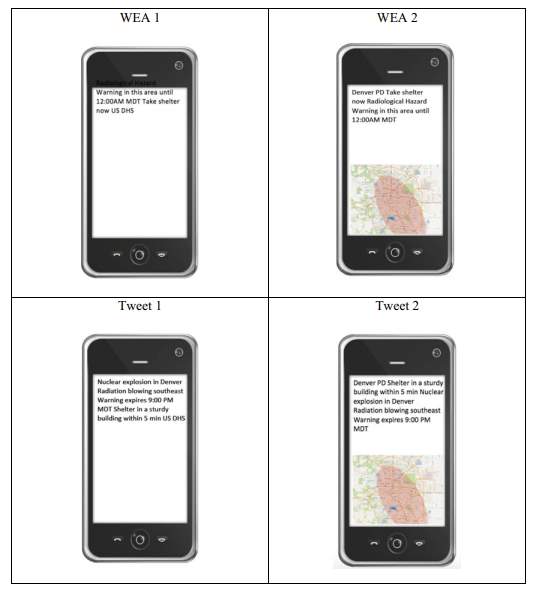
Figure 4, (Bean et al, 2016)
In a 2016 study by Bean et al., the researchers conducted a study on how audiences would interpret a mobile alert for a unfamiliar hazard. They used four focus groups using an improvised nuclear device as the scenario. The study found that “While participants offered a wide variety of interpretations, WEAs and tweets were deemed confusing, difficult to believe and impersonal. Participants also consistently found WEAs and tweets to be fear inducing and uninformative. The findings compel improvements in the way that WEAs and tweets are currently written, as well as indicate future directions for applied risk and crisis communication theory development.
12-18 year old’s participated in, “scenarios relating to flooding and the discovery of an unexploded World War Two bomb and were shown example alerts that might be sent out in these circumstances. Intended compliance with alerts was high. Participants noted that compliance would be more likely if: they were familiar with the system; the messages were sent by a trusted source; messages were reserved for serious incidents; multiple messages were sent; messages were kept short and formal” (Wong, Jones, and Rubin, 2017).
False Alerts
When thinking about the impact of a false alarm, one must also consider how the public is going to respond if another alert goes out in the future. The next time an alert goes out, many people may not think they can rely on the accuracy of the government and may not respond in time. A case study by Ripberger et, al. found that, “subjective perceptions are—in part—a function of objective experience, knowledge, and demographic characteristics. When considered in tandem, these findings support the proposition that errors influence perceptions about the accuracy of warning systems, which in turn impact the credibility that people assign to information provided by systems and, ultimately, public decisions about how to respond when warnings are issued” (Ripberger et. al., 2015).
However, in air traffic controllers, the study by Wickens et al, found that the employees will still respond in the event of a false alarm. “Although centers with more false alerts contributed to more nonresponses, there was no evidence that these were nonresponses to true alerts or that response times were delayed in those centers. Instead, controllers showed desirable anticipatory behavior by issuing trajectory changes prior to the alert. Those trajectory pairs whose conflicts were more difficult to visualize induced more reliance on, and less compliance with, the alerting system. Conclusion: The high false-alarm rate does not appear to induce cry wolf behavior in the context of en route ATC conflict alerts” (Wickens et,al., 2009). (Paraphrase)
Thesis state/purpose statement
The goal of this research is to bring attention to nuclear security as it is a national threat, especially in today’s geopolitical climate. Hawaii is the focus of this study due to the limited resources they have in the event of a ballistic missile or nuclear attack. The goal of this research is to better understand what other states and territories do to prepare for nuclear attacks to suggest ways that could better assist Hawaii’s public in the event of a nuclear attack.
Methodology
Preparedness is the first step to a problem, especially when it comes to nuclear security. With the increasing global focus on the use of Nuclear power, it is now even more important to have a preparedness plan in place in the event of a nuclear detonation, even if it is an accident. Hawaii has come into the spotlight due to the recent mishandling of a nuclear exercise that left millions of people panicked for 38 minutes when they received a text notification that a ballistic missile was inbound, and they needed to take immediate shelter. The purpose of this research is to examine Hawaii’s preparedness efforts prior to the events of 13 January 201 due to the limited resources they may have to respond in the event of an inbound ballistic missile. The research goal is to better understand commonalities among other states and territories, using this could better assist Hawaii in the event of a nuclear attack.
The following research questions will guide this process:
- Looking at newspaper and media reports of the false alarm, how does the public view an emergency manager’s role in a nuclear attack?
- How does fear come into play for public perception?
- What is Hawaii’s current Hazard Mitigation Plan?
- What does it say about nuclear planning?
- In the event of a nuclear attack, does Hawaii have the necessary resources to respond?
- What is a realistic plan for Hawaii?
The research was conducted using a qualitative approach to allow for a understanding of emergency management efforts for nuclear security. The research study focuses on qualitative data that was collected using newspaper reports and primary government documents. A condition was that the newspapers had to be produced in Hawaii which allowed for a local perspective on the missile alert that went out. Any newspapers that fell outside of that criteria were discarded. Primary local, state, and federal Government documents will allow for a comprehensive understanding of preparedness and situational awareness that exists in Hawaii.
Analysis/Data Collection
Local Newspapers
The Hawaii newspapers were found using Georgetown library online database. Specifically using ProQuest Centrals platform and search Hawaii missile alert. The articles were there narrowed down by geographical location and then date in which the articles were published. The top 50 sources were looked at, even with specifying the region, many sources had to be pulled out due to the articles not being in Hawaii. The top 24 news articles were used for this analysis, the only news source being Honolulu Star- Advertiser. After the articles were found, they were coded using NVivo software. The articles were run through NVivo automatic software which codes themes within each newspaper. The picture is attached on the right of the findings. Three major themes were found within the 24 articles: Missile, Alert, and Emergency.
Continental United States Newspapers
The newspapers used for this research were found using ProQuest centrals platform. The terms searched were Hawaii missile alert, articles were then narrowed down by language (English), region needing to be in the United States. A total of 17 articles were selected and coded using NVivo. The articles went through NVivos automatic software coder the top three themes were Alert, Missile, and Emergency. The themes that were found are pictured to the right.
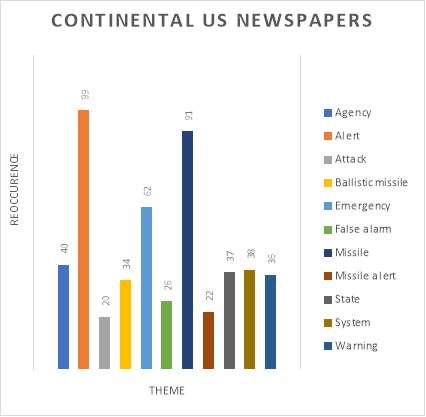
Hawaii Hazard Mitigation Plan
Hawaii’s hazard mitigation plan is quite extensive, while there is nothing specifically on a nuclear attack or an attack from another government, it does cover bioterrorism. The hazards that is does plan for (pictured on the right) can have valuable resources that could be used for a nuclear attack. Hawaii does have emergency shelters in place if they would need one, however in the County and city of Honolulu they only have shelter space for 30% of their population. There is also a lack of emergency shelter space on other islands, however in 2005, they did allocate $4 million dollars to retrofit shelters. The plan also includes what hospitals are in which cities. They also use GIS technology in order to see what capabilities they may still have left after a natural disaster.
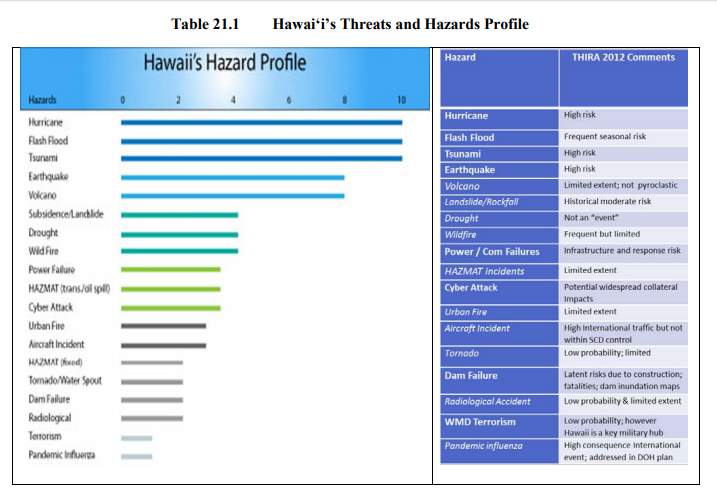
Figure 5, (Hawaii State, 2013)
As new threats emerge we must prepare for them by engaging the public and having a strong hazard mitigation plan. “Manmade hazards such as terrorism and technological disasters—has become all too apparent, as demonstrated by the September 11, 2001 attacks on New York City and Washington, DC and the July 2001 hazardous material train derailment and fire in Baltimore, Maryland. Additionally, the 2001 anthrax attacks, the 1996 bombing at the summer Olympics in Atlanta, the 1995 destruction of the Murrah Federal Building in Oklahoma City, the 1993 World Trade Center bombing, and scores of smaller-scale incidents and accidents reinforce the need for communities to reduce their vulnerability to future terrorist acts and technological disasters” (FEMA, 2003). The 2013 Hazard mitigation plan also establishes how tourism and lifelines are 100% dependent on maritime shipping. If someone were to target shipping docks, then this could cut off access to food, water, and supplies for days or weeks. The two charts represent the major events that have occurred within the united states since 1993.
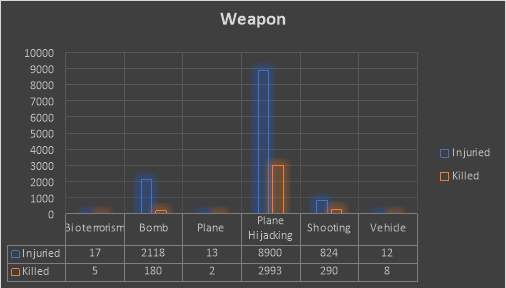
The top chart (in black), represents the method of weapon that was chosen, it also shows how many people were injured and killed. The Chart below, breaks down the time period these events occurred. This is important because it shows that preparedness is important because one never knows when a hazard may present itself.

Guam
Guam has an extensive hazard mitigation plan; however, it also doesn’t include an attack by a foreign government. However, the local emergency management has issued pamphlets to their citizens in the event of a nuclear attack.
Preparedness
In schools, there are monthly or quarterly tornado drills in many communities, in the event of a tornado. Students and teachers know what to do if the tornado sirens go off. Practice builds muscle memory, this allows for faster response time.
Unattended consequences- > emergency response drill, alert, information given, how do we take this all hazards approach, need to stop and listen.
Responsibility
The responsibility of a nuclear alert has been resting with local emergency mangers in Hawaii. However, due to the recent false missile alert that went out on January 13, 2018, Senator Brian Schatz has stated a missile attack should be a federal responsibility. Schatz stated, “a missile attack is not a local responsibility. Confirmation and notification of something like a missile attack should reside with the agency that knows first and knows for sure. In other words, the people who know should be the people who tell us. That is why I’m introducing legislation with Sens. Harris, Gardner and others to make it clear that the authority to send missile alerts should rest with the Department of Defense and Homeland Security. These agencies have to work with the state and local Emergency Management Agencies when they get the word out so that the public is safe and informed” (Nakso, 2018). The lag in time that it takes to communicate with local authorities to inform the public, could be seconds that count for their safety in an emergency. During the cold war, the responsibility laid with the federal government, they released information to the public about how to prepare for a nuclear attack. Shelters were established, Duck and Cover went out to the school children and many families had their own fallout shelters.
Recommendations
Preparing for a nuclear crisis is immensely difficult because there a various factors that come into play; where the detonation is, the wind speed, food contamination, medical and recovery. “A nuclear blast would all but certainly contaminate local food and water sources. This would present a particular hardship for Hawaii, given its isolation. Still, the danger would wane after six to eight weeks for most food and slightly longer for milk. (Fallout can contaminate large areas of grazing pasture and then concentrate in the milk of the cows that ingest it” (Tucker, 2018).
Medical needs have to be analyzed; however the radiation fallout could make that difficult. “A recent Institute of Medicine report looked at the nation’s ability to respond to the medical needs that would arise following a terrorist nuclear event and found preparedness is sorely lacking. “The report provides a frightening but candid look into our level of preparedness today,” wrote APHA Executive Director Georges C. Benjamin, MD, FACP, FACEP (E), in the report preface as chair of its authoring committee” (Currie, 2009).
Problems
Funding to help prevent a nuclear attack could become an issue, “in 2002, the President of the United States directed the Department of Defense (DOD) to field an integrated, interconnected, and layered Ballistic Missile Defense System (BMDS) capable of defending the U.S. homeland, deployed troops, friends, and allies against ballistic missiles of all ranges in all phases of flight. DOD has spent over $80 billion to develop the BMDS, and since its initial fielding has added additional capabilities. Since there is limited time available to intercept an incoming missile, integrating training among all organizations involved is essential to connect the seams where the commands and services must work together. However, DOD recognizes that funding for training will face significant budget pressures amid the department’s competing demands for current operations, acquisitions, and personnel expenses. The BMDS is comprised of various land- and sea-based elements,1 including radars, interceptors,2 and command and control systems that are employed together to effectively intercept an incoming missile. Ballistic missile defense is an inherently joint operation that may require the simultaneous involvement of multiple commands and services which operate the system’s elements”(GAO, 2011).
During the disaster/what to do
Standard guidance on what to do in a nuclear disaster from (Toussaint, 2018), ready.gov, homeland security, FEMA.
- Distance yourself from the explosion
- Seeking shelter underground if possible
- Shield yourself from the fallout
- Get behind thick walls, concrete, bricks
- Fallout radiation loses intensity rather quickly
- First two weeks pose the greatest threat
- Stay inside for at least 24 hrs, unless otherwise notified by government officials
- Look away from the flash or fireball, it can blind you.
- Take cover under anything that may offer protection
- Lay flat on the ground with your head covered
- It could take 30 seconds for the blast wave to hit you.
- Get clean as possible
- Remove contaminated clothing
- Outer layer of clothing can remove up to 90% of the radiation.
- Do not scrub or scratch yourself while showering
- Use soap but not conditioner, conditioner will trap radiation into your hair.
- Keep listening to the news and radio.
Limitations
The amount of news articles available are limited, due to not having access to local Hawaiian newspapers.
Conclusion
As we found with Hawaii, the citizens were unsure of how to respond to a nuclear attack. The emergency management team also were unprepared to send out a second message to the public and didn’t have proper procedure in place at the time. Right now, Hawaii is unprepared for a nuclear attack, it is important that citizens know what to do and there is a complete all-hazards mitigation plan in place.
References
Ballistic Missiles. (2018). Retrieved February 13, 2018, from https://www.rand.org/topics/ballistic-missiles.html
Bean, H., Liu, B. F., Madden, S., Sutton, J., Wood, M. M., & Mileti, D. S. (2016). Disaster warnings in your pocket: How audiences interpret mobile alerts for an unfamiliar hazard.Journal of Contingencies and Crisis Management, 24(3), 136-147. doi:10.1111/1468-5973.12108
Burchfield, L. A. (2009). Radiation safety : protection and management for homeland security and emergency response. Retrieved from https://ebookcentral.proquest.com
Caston, L., Leonard, R. S., & Mouton, C. A. (2014). The future of the u.s. intercontinental ballistic missile force. Retrieved from https://ebookcentral.proquest.com
Cova, T. J., Dennison, P. E., Li, D., Drews, F. A., Siebeneck, L. K., & Lindell, M. K. (2016). Warning triggers in environmental hazards: Who should be warned to do what and when?: Warning triggers in environmental hazards. Risk Analysis, 10.1111/risa.12651
Cova, T. J., Drews, F. A., Siebeneck, L. K., & Musters, A. (2009). Protective actions in wildfires: Evacuate or shelter-in-place? Natural Hazards Review, 10(4), 151-162. 10.1061/(ASCE)1527-6988(2009)10:4(151)
Currie, D. (2009). U.S. not fully prepared for nuclear attack. The Nation’s Health, 39(7), 8. Retrieved from http://proxy.library.georgetown.edu/login?url=https://search.proquest.com/docview/198495907?accountid=11091
FEMA, (2008). Local multi-hazard mitigation planning guidance. U.S. Department of Homeland Security (2008 July 1)
Forum, O. M. A. P. H., Board, O. H. S. P., & Institute, O. M. (2013). Nationwide response issues after an improvised nuclear device attack : medical and public health considerations for neighboring jurisdictions: workshop summary. Retrieved from https://ebookcentral.proquest.com
Frazier, T. G., Walker, M. H., Kumari, A., & Thompson, C. M. (2013). Opportunities and constraints to hazard mitigation planning. Applied Geography, 40, 52-60. 10.1016/j.apgeog.2013.01.008
Godschalk, D. R. (2003). Urban hazard mitigation: Creating resilient cities. Natural Hazards Review, 4(3), 136-143. 10.1061/(ASCE)1527-6988(2003)4:3(136)
Johnston, R. (2018, March 24). Terrorist attacks and related incidents in the United States. Retrieved from http://www.johnstonsarchive.net/terrorism/wrjp255a.html
Nakaso, D. (2018, Jan 26). ‘Button pusher’ not cooperating with multiple investigations. Honolulu Star – Advertiser Retrieved from http://proxy.library.georgetown.edu/login?url=https://search.proquest.com/docview/1991576298?accountid=11091
Nuclear Blast. (n.d.). Retrieved February 13, 2018, from https://www.ready.gov/nuclear-blast
Press, T. A., Honore, M., Grube, N., Teague, C., Eagle, N., Estrellon, A., & Oppegaard, B. (2018, February 06). North Korean Missile Threat. Retrieved February 13, 2018, from http://www.civilbeat.org/topics/north-korean-missile-threat/?gclid=CjwKCAiAk4XUBRB5EiwAHBLUMZABb-uLAmKg9buT9wUBQl1ZHd742VJevMSBaO5sbmDhjDw_kn6qcRoCSCMQAvD_BwE
Quarantelli, E. L. (1997). Ten criteria for evaluating the management of community disasters.Disasters, 21(1), 39-56. 10.1111/1467-7717.00043
Quirk, M. (2009). Review of Nuclear Safeguards, Security and Nonproliferation: Achieving Security with Technology and Policy. Journal of Homeland Security and Emergency Management, 6(1), pp. -. Retrieved 12 Feb. 2018, from doi:10.2202/1547-7355.1575
Ripberger, J. T., Silva, C. L., Jenkins‐Smith, H. C., Carlson, D. E., James, M., & Herron, K. G. (2015). False alarms and missed events: The impact and origins of perceived inaccuracy in tornado warning systems. Risk Analysis, 35(1), 44-56. doi:10.1111/risa.12262
Sorensen, J., & Rogers, G. (1988). Local Preparedness for Chemical Accidents: A Survey of U.S. Communities. Industrial Crisis Quarterly, 2(2), 89-108. Retrieved from http://www.jstor.org.proxy.library.georgetown.edu/stable/26162744
Tanimura, K., Ito, H., & Kimura, H. (2013). Nuclear Security and Incident Response. 62. Retrieved February 13, 2018, from http://www.hitachi.com/rev/pdf/2013/r2013_03_106.pdf
Tucker, P. (2018, January 19). What A Nuclear Missile Attack On Hawaii Would Look Like. Retrieved February 13, 2018, from http://www.defenseone.com/threats/2018/01/what-nuclear-missile-attack-hawaii-would-look/145319/
United States. Federal Emergency Management Agency. (2003). Integrating manmade hazards into mitigation planning (Version 2.0. ed.). Washington, D.C.: FEMA, U.S. Dept. of Homeland Security.
United States. Federal Emergency Management Agency. (2008). Local multi-hazard mitigation planning guidance. Washington, D.C.: U.S. Dept. of Homeland Security, FEMA.
United States. Government Accountability Office. (2010). Information security: National nuclear security administration needs to improve contingency planning for its classified supercomputing operations : Report to congressional requesters. Washington, D.C.: U.S. Govt. Accountability Office.
United States. Government Accountability Office. (2011). Ballistic missile defense: Actions needed to improve training integration and increase transparency of training resources : Report to congressional committees. Washington, D.C.: U.S. Govt. Accountability Office.
Wickens, C. D., Rice, S., Keller, D., Hutchins, S., Hughes, J., & Clayton, K. (2009). False alerts in air traffic control conflict alerting system: Is there a “cry wolf” effect? Human Factors: The Journal of the Human Factors and Ergonomics Society, 51(4), 446-462. doi:10.1177/0018720809344720
Wong, D. J., Jones, E., & Rubin, G. J. (2018). Mobile text alerts are an effective way of communicating emergency information to adolescents: Results from focus groups with 12‐ to 18‐year‐olds. Journal of Contingencies and Crisis Management, 26(1), 183-192. doi:10.1111/1468-5973.12185
Cite This Work
To export a reference to this article please select a referencing stye below:
Related Services
View allRelated Content
All TagsContent relating to: "Government"
A Government is a collection of people in the position to govern a country or region. Governments have the power and authority to debate and make decisions on behalf of their people.
Related Articles
DMCA / Removal Request
If you are the original writer of this dissertation and no longer wish to have your work published on the UKDiss.com website then please:




